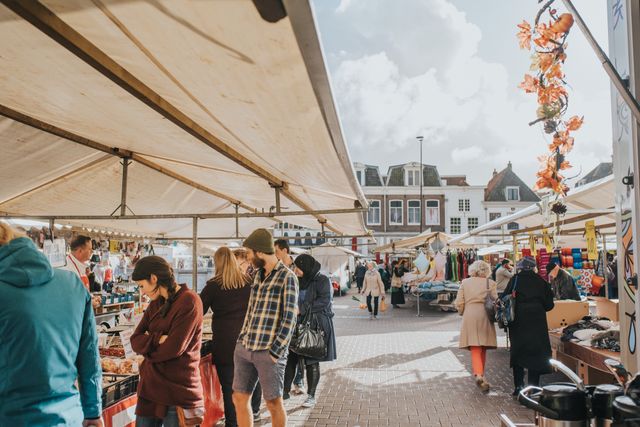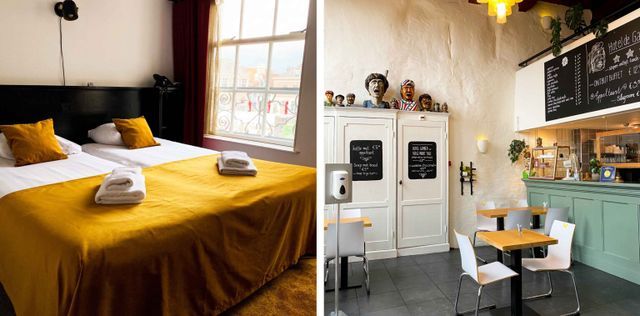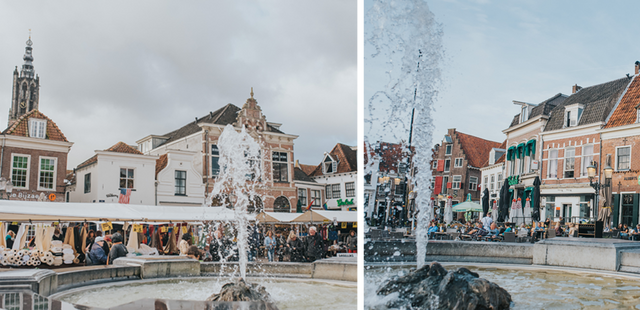Amersfoort and history; the two simply belong together. Indeed, our city simply breathes history. It seeps here from every nook and cranny. You can't get around it. So too on the Hof - Amersfoort's largest square - which has had various functions over time. Some very cozy others quite sinister. Curious? Come I'll take you with me!
What's in a name?
Where exactly does the name the Hof come from? Former names of this lively square are the Hoff and Coornmerkt (corn market). And these go all the way back to a medieval bishop's court. Located on a spur of the Utrecht Heuvelrug, around which the river Eem flowed with a curve. This so-called bishop's court is mentioned in a charter as early as 1203, so we know that the Hof has existed since 1196.
Century-old market square

Both in the 13th and 14th centuries, the Hof was raised several times to make it more suitable for markets. In the 16th century, the Hof was even paved and known as Marktveld. The place for all markets in the city of Amersfoort. Extraordinary that the place where you can still go to the market on Friday and Saturday now, so people have been doing that for centuries. For weekly shopping and the latest gossip. What you can find on the market these days for all the goodies and beautiful things? Check it out here!
The old city hall of Amersfoort
Amersfoort's Town Hall used to be located at Hof, near number 12. It is no longer there, but the street name Achter Het Oude Stadhuis still reminds you of it. It was first two and later three buildings. Of which the earliest phase of construction dates from the 13th century. From 1536 the Amersfoort city hall was located in a residential tower and adjacent building. In the 17th century, the third building was also bought up. The town hall was modified several times over the years. Until it moved to the Westsingel in the early 19th century. Since 1974, the city hall has been located on the Stadhuisplein and soon on the now vacant Trapezium site.
St. George's Church

St. George's Church is the eye-catcher of Hof. A historic building that can still be admired today. A bishop's court was founded here in the 12th century. This court included a chapel, which was probably dedicated to "Saint George. In 1248, the chapel was replaced by a Romanesque hall church, which was later rebuilt into a Gothic cruciform church. From the early 15th century to 1534, the church was expanded into a three-aisled hall church, enclosing the 1190 tower. The once-painted medieval paintings were restored 40 years ago. And again in 2010-2011, the Sint-Joriskerk was restored. This time because the historic oak roof structures were infested by the Pied Piper.
There is much more to tell about this extraordinary monument. Want to visit it? Just check if it is open. Because every Sunday it is in use for church services and on the other days of the week it is regularly rented out for concerts, conferences and receptions.
George and the dragon

Near St. George's Church you will find a small colonnade from 1608. Called Butter Hall, Boterwaag and Boterbeurs. In 1616 it functioned as a bell keeper's house and today you will find the office of the market master. On the building since 1992 sits a small musical clock, where every hour Sint Joris and the dragon come out. Saint George is the patron saint of Amersfoort and he defeats the dragon every hour. I think almost every child in Amersfoort has seen this little scene once.
A piece of lurid history
And more executions took place at the Butter Hall. For in the past all death sentences were pronounced in the Courtroom in the Town Hall at Hof. The sentence was then carried out in front of the Butter Hall. The methods of execution here in Amersfoort consisted of; the sword, hanging or radbraken until the introduction of the guillotine. Fortunately, capital punishment was abolished in 1870.
Staying at the Hof

Back to a lighter subject. The stately building at number 15 - where you now find Gastrobar The Professor, once housed fashion house "The City of Paris. Sounds luxurious right? Too bad there's no such thing as a time machine. I would have loved to take a look there. Another old stone building is Logement de Gaaper from around 1225. Here you encountered an apothecary from 1822. The gaper that adorned the building was donated to Flehite, where you can still see it. Nowadays you can stay at the Gaaper during your citytrip in our bustling city.
Another dragon?

At the center of Hof is our city fountain. A fountain in which a bronze face can be seen spouting water from its mouth. Stories circulate about a dragon who sat under this spring. And who knows, maybe it is still there?
At the Hof you won't just find beauties from a distant past and mystical creatures like dragons. You can also stroll around the market, discover unique stores in the side streets, eat out extensively or have dances and drinks. Will you stop by too?
Source: Home - Archives Eemland
